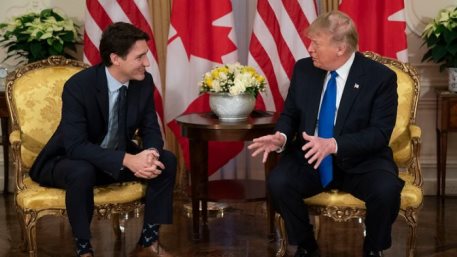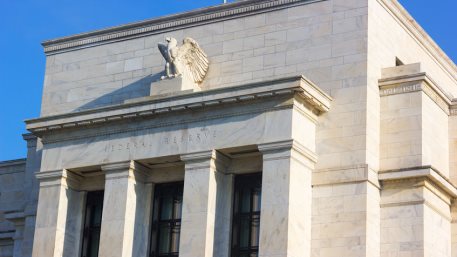
The FOMC is scheduled to hold a meeting this week on Wednesday, on which the board of directors of the FED is going to decide how to adjust its monetary policy stance, and the sweeping market forecasts all point towards an almost inevitable interest rate cut as the most likely outcome of the meeting.
The expectation for a reduction of the rate by 25 basis points to 2.25 per cent is prompted by deteriorating internal economic factors in the US on the one hand, and also by the growing tensions surrounding the so-called currency war on the other.
Concerning the employment conditions in the US, the labour market is still looking extremely favourable and resilient with only a slight growth in overall unemployment with 1 per cent for the month of June to 3.7 per cent, which can still be interpreted as the labour market operating at full-employment.
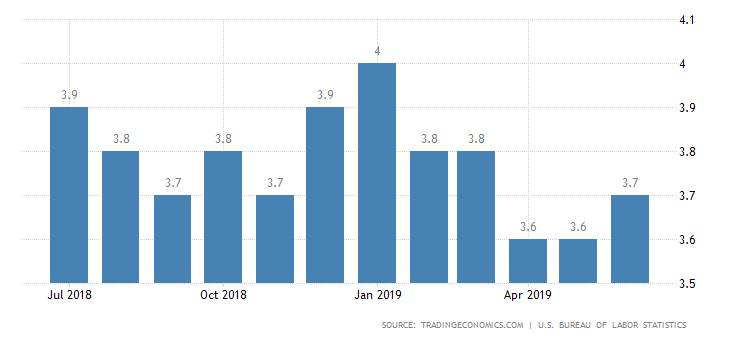
In regards to the price-setting environment in the country, the falling inflation rate is arguably the most alarming trend in the performance of the overall American economy, and it is also the most likely factor to weigh in on Jerome Powell and the FOMC’s ultimate decision on Wednesday, in favour of an interest rate reduction.
The inflation rate has fallen to 1.6 per cent in June from the registered 1.8 per cent in the previous month, which is not only a deviation from the target level of 2 per cent symmetrical inflation, but is also the most striking indication that the current monetary stance of the FED is no longer accommodative of economic expansion and fiscal stability.
Further information about the causes that led to the falling inflation rate and the likely ramifications for the overall economy from the weaker inflation can be found here
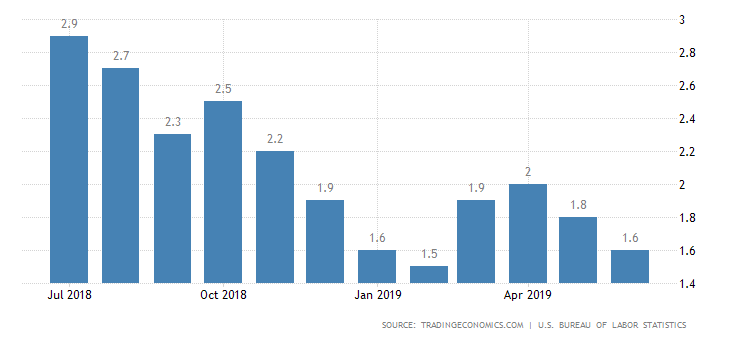
In addition to the marginally rising unemployment and deteriorating inflation, the ECB has implied a possible rate cut by the end of the year which would give European companies a certain competitive advantage over their American counterparts, as the Euro becomes more appealing to foreign investors. Thus, Jerome Powell and the FED are now being pressured even harder by Wall Street and Washington to cut the rate in order to weaken the strong dollar and gain an advantage in international trade over the EU bloc.
The US Dollar Currency Index is currently trading at 98.03, which is just below the 98.15 resistance level that has been last tested on the 30th of May. The index has been rising more or less steadily since last week and depending on just how much the market has been able to price in a rate cut on Wednesday, the resistance level should be able to hold, even though the expected high volatility following the interest rate decision announcement might send the price temporarily above the level.
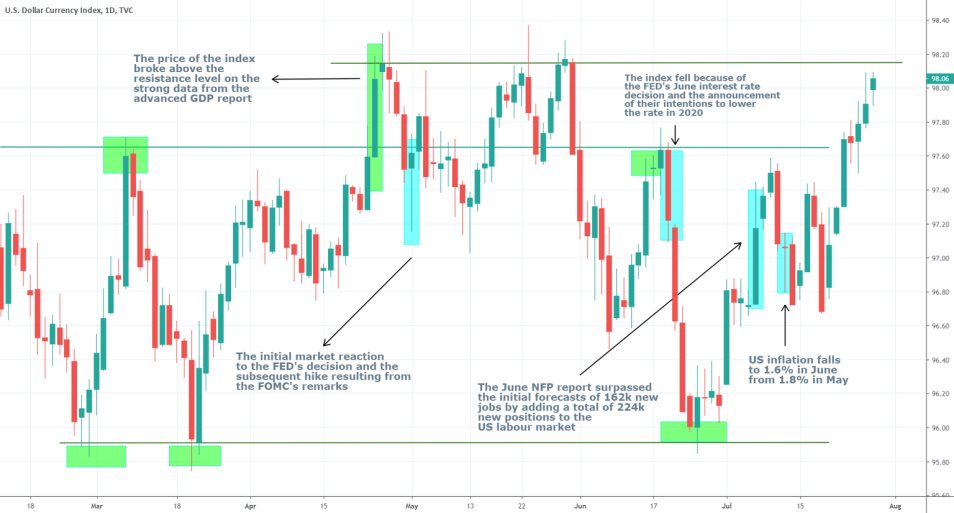
Trendsharks Premium
Gold is undergoing a correction, as investors take profits to offset losses from falling stock prices, impacting their margins. However, we anticipate a renewed wave of [...]
The Swiss stock market index is mirroring its global counterparts, such as Germany 40 and US100, experiencing a sharp decline following the announcement of new [...]
We’re analyzing the weekly chart to grasp the broader market trend. Over the past three years, the US30 index has surged by 17,000 points, often resembling a nearly straight [...]
Over the past week, the DAX has experienced a sharp decline, plunging by an astonishing 3,400 points. This downward movement is not isolated, as its international counterparts, such as the UK100 and US100, are also facing significant [...]
EURUSD recently formed a double top at 1.0930, signaling a potential trend reversal, and has since begun a correction. After a 600-pip rally since early March, a pullback at this stage is both expected and healthy. Given these conditions, we are placing a [...]
Since early March, EURJPY has surged nearly 1,000 pips, providing us with several excellent trading opportunities. However, as the rally matures, many early buyers are beginning to take profits, leading to a noticeable slowdown in the uptrend. On Friday, the pair formed a [...]
The AUDJPY currency pair continues to be dominated by bullish momentum, as multiple golden cross patterns reaffirm the strength of the ongoing uptrend. Despite this, we are witnessing a much-needed [...]
The EURAUD currency pair appears to be undergoing a trend reversal, signaling a potential shift in market direction. A notable technical development is the formation of a Death Cross on the chart, a widely recognized bearish indicator that typically suggests a [...]
After securing an impressive 200-pip profit last week, the EURJPY currency pair is now undergoing a southward correction, retracing some of its recent gains. Despite this temporary pullback, the Golden Cross remains intact, reinforcing our view that the overall trend continues to be [...]
The appearance of a Golden Cross in Silver strengthens our analysis that the metal is currently in a strong uptrend, indicating further bullish momentum in the market. This technical pattern, where the short-term moving average crosses above the [...]
This trade presents a considerable level of risk and can be classified as an opportunistic move based on recent price action. The GBPUSD currency pair has experienced a substantial bullish rally, surging by nearly 500 pips in a strong upward movement. However, after this extended period of appreciation, the pair is showing signs of a potential [...]
The anticipated Death Cross on the SMI20 appears to be failing as price finds strong support at the 23% Fibonacci retracement level. After testing this area, the index has shown bullish strength, printing several large green candles, signaling an increase in [...]
A Golden Cross has just appeared on the USDJPY chart, signaling a potential bullish move. This technical pattern occurs when the 20 period moving average crosses above the 60 period moving average, a widely recognized indication of increasing [...]
After 2 months of a down trend, we finally see some indications of price recovery for Oil. The golden cross, a historic buy signal, supports this [...]
For the past month, the German DAX40 has experienced a remarkable 10% surge, reflecting strong bullish momentum. Despite ongoing market volatility and frequent pullbacks, every dip continues to attract fresh buyers, reinforcing the [...]
Oil continues its downward trajectory, despite occasional pullbacks. The overall trend remains bearish, reinforced by multiple Death Cross patterns, a classic sell signal indicating further weakness. Adding to this bearish outlook, the critical [...]
Over the past few days, gold has experienced a sharp decline of more than $100. This downturn can be attributed in part to traders securing profits to manage their margins, which are under strain due to the significant drop in major indices. Currently, gold has fallen below the [...]
The NASDAQ 100 index is showing strong bullish momentum, as evidenced by the formation of a Golden Cross on the chart. This classic buy signal occurs when the short moving average crosses above the long term moving average, suggesting that upward momentum is [...]
The EURAUD currency pair has encountered a significant resistance level, failing to break above the critical 61% Fibonacci retracement level. This suggests that bullish momentum is weakening, reinforcing the case for a potential downward move. Given this technical setup, we favor entering a [...]
The UK100 is experiencing a remarkable rally! Over the past few weeks, the British stock market index has surged nearly 800 points. Each minor dip has attracted more buyers, fueling the bullish momentum. However, since last week, we’ve observed a slight [...]




















